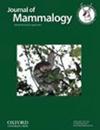有耳昆虫与食节肢动物蝙蝠之间的声听特征相互作用:利用 DNA 方法评估食性
IF 1.6
3区 生物学
Q2 ZOOLOGY
引用次数: 0
摘要
节肢动物与蝙蝠之间的相互作用通常被视为研究捕食者与被捕食者共同进化过程基本因素的基础模型。蝙蝠发展了超声回声定位来捕食,作为回应,一些节肢动物发展了超声听觉等防御机制,使它们能够躲避蝙蝠捕食者。本研究分析了蝙蝠的捕食模式,重点研究了捕食者与被捕食者互动过程中的声波-听觉感知机制。粪便样本中的新一代 DNA 序列数据被用来分析墨西哥 17 种蝙蝠的食性。根据听觉特征对节肢动物猎物类群进行了分类,并根据文献回顾重新编制了回声定位数据。我们(i)根据听觉能力对节肢动物科进行分类;(ii)估算节肢动物类群的丰富度和在每种蝙蝠食物中的比例;(iii)使用多维标度、主成分分析和回归分析猎物消耗模式与其听觉特征的关系以及与蝙蝠回声定位特征的关系。最后,我们分析了觅食时间与猎物听觉特征之间的关系。具有听觉器官的科分别属于鳞翅目和直翅目。我们登记了 20 个鳞翅目科和 5 个直翅目科,其中分别有 7 个和 3 个科具有听觉器官。在这些目中,少数蝙蝠物种的食谱中记录了无耳科。我们的研究结果支持异频假说,即捕食者和猎物之间的发射频率间隔存在差异。然而,我们发现无耳蛾的食用频率较低,而且与昼夜活动和黄昏活动有关--因此,它们的食用仅限于早期觅食的蝙蝠物种。结果表明,尽管猎物具有超声波听觉能力,蝙蝠仍能成功捕食节肢动物猎物。这些结果可能是由于蝙蝠与有耳昆虫之间的反适应能力使捕食者有利的不对称 "军备竞赛 "得以维持。本文章由计算机程序翻译,如有差异,请以英文原文为准。
Interaction of sound-audition traits between eared insects and arthropodophagous bats: using a DNA approach to assess diet
Arthropod–bat interactions are often considered as a base model for studying factors underlying predator–prey coevolutionary processes. Bats developed ultrasonic echolocation to hunt, and in response some arthropods developed defense mechanisms such as ultrasonic hearing, allowing them to elude bat predators. The present study analyzes the feeding patterns of bats, focusing on sonic-auditory sensory mechanisms in predator–prey interactions. Next-generation DNA sequence data from fecal samples were used to analyze the diet of 17 bat species from Mexico. Arthropod prey taxa were classified according to their auditory traits, and echolocation data were recompiled from literature review. We: (i) classified arthropod families according to their hearing ability; (ii) estimated arthropod taxon richness and proportion in the diet of each bat species; and (iii) used multidimensional scaling, principal component analysis, and regression to analyze prey consumption patterns in relation to their auditory traits and in relation to echolocation characteristics of bats. Finally, we analyzed the relationship between foraging time and auditory characteristics of prey. Families with hearing organs correspond to the orders Lepidoptera and Orthoptera. We registered 20 families of Lepidoptera and 5 of Orthoptera—7 and 3 with hearing organs, respectively. Of these orders, families lacking ears were recorded in the diet of a few bat species. Our results support the allotonic frequency hypothesis predicting a difference in emission frequency intervals between predator and prey. However, we found that the consumption of earless moths is less frequent and is related to diurnal and twilight activity—hence, their consumption is limited to bat species foraging early. Results indicate bats feed on arthropod prey successfully despite the ultrasonic hearing ability of the prey. These results may be due to counteradaptations that allow maintenance of an asymmetric “arms race” between bats and eared insects that favors the predator.
求助全文
通过发布文献求助,成功后即可免费获取论文全文。
去求助
来源期刊

Journal of Mammalogy
生物-动物学
CiteScore
3.30
自引率
5.90%
发文量
106
审稿时长
4-8 weeks
期刊介绍:
Papers are published on mammalian behavior, conservation, ecology, genetics, morphology, physiology, and taxonomy.
 求助内容:
求助内容: 应助结果提醒方式:
应助结果提醒方式:


